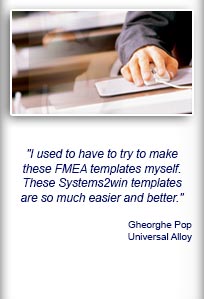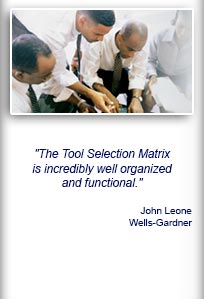Installation and Setup
Installation - Each User. Installation - Multi-user. Language Translations. Personalize Your Templates.Systems2win Training.
Quick Start Initial Training. New User Training. Training Matrix. Systems2win Leadership. Training Classes.Lean Training
Lean Training and Coaching. Lean Principles. Muda 8 Wastes. Goal - Lean Flow. Roadmap - Lean Journey. Value Stream Mapping. Standard Work. Hansei Lean Thinking. Lean Dictionary. Online Lean Training. Lean Leadership.Microsoft Office Training
Excel Training. Excel Drawings (without Visio). Excel Charts. Word Training. PDF Training. Document Storage and Naming.Support
Support.Voice of the Customer Tools
Word and Excel templates for Voice of the Customer and Kano Analysis
Whether you are doing strategic policy deployment, value stream mapping, or the lean method of process improvement...
the recommended first step is always the same...
Start with a clear understanding of your customers' true needs
And the typical response is usually...
"We've already done that."
Sure you have.
And after re-reading the first chapter of Lean Thinking, by Jim Womack, you might be more receptive to do it again....
more thoroughly.
Voice of the Customer Templates
All of the templates and online training that you need to do Voice of the Customer Analysis correctly, and to empower every team member to use standardized tools and systems, for consistent, reliable results
Voice of the Customer Data Collection (VOC_Data.docx)
Simple-to-use Word template
to plan and manage collection of customer data
from existing company data, listening posts, social media, surveys, interviews, point-of-use observation, and more
See training in the section below

Customer Wants Worksheet (VOC_Wants.docx)
This simple Word template is designed to be easily distributed to customers, customer-facing employees, senior executives, and other stakeholders, to get their insights into that all-important question:
"What do our customers want from us?"
Because many of these stakeholders will not own a license for your Systems2win templates, this Word template does not require each user to have the Systems2win application installed.

Voice of the Customer Requirements Translation
and Kano Analysis (VOC_Kano.xlsx)
Customers rarely communicate clearly.
Use this template to translate potentially vague customer comments into measurable functional requirements, thereby strengthening your team's ability to design and deliver products and services that truly delight your customers
See training in the section below

Operational Definitions (Op_Def.xlsx)
Use your Operational Definitions template to avoid this costly mistake...
Inconsistent collection and interpretation of Check Sheet data, measurement criteria, the results of surveys, and other Voice of the Customer data.
When Jack gathers data this way, and Jill interprets it another way...
your entire Voice of the Customer listening efforts were wasted.

Customer Segmentation Worksheet (CustSegment.docx)
Use your Customer Segmentation template
to better understand and clarify the differing needs of your differing customers.
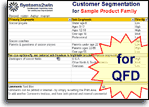
Critical to Quality (TreeCritical.xlsx)
Measures Tree (MeasuresTree.xlsx)
and other Tree Diagrams (TreeDiagram.xlsx)
Use your tree diagram templates:
a) to better segment your customers
b) to ensure that the product or process characteristics that you measure and control will actually satisfy your (segmented) customers' desires

Measurement Selection Matrix (MeasuresSelect.xlsx)
One of the most compelling reasons to seek and analyze Voice of the Customer data is to answer the question:
"What should we measure — that our customers care most about?"
And the fastest, simplest way to answer that question is to use your Measurement Selection Matrix

Cause and Effect Matrix (CauseEffect.xlsx)
Your Cause & Effect Matrix provides another pretty simple way to answer that same (so very important) question:
"What should we measure — that our customers care most about?"
That question is important enough that many teams will use multiple tools, to consider customer needs from multiple perspectives.
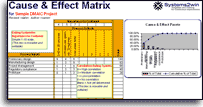
House of Quality
Quality Functional Deployment Matrix (QFD.xlsx)
Answering that same question is so important that it sometimes justifies bringing out the big gun.
One of the most sophisticated quality improvement tools, your QFD template provides a guiding structure for a cross-functional product development team to rapidly design and deploy new products and services.

Voice of Customer Data Sources

Your VOC Data Collection template (VOC_Data.docx)
is extremely easy to use.
Simply use it as a place to brainstorm and organize all of your 'Customer Listening Posts'
All of your (formal and informal) systems for how you observe and listen to
the (formally and informally) expressed needs and desires of YOUR customers.
As you complete your Voice of the Customer Data Collection worksheet, here are some idea starters..
Existing Customer Information
Examples: Gross sales for this product or service, existing sales analysis data, returns or refunds, order cancellations, won/lost reporting, source of leads reporting...
Advantages: Cheap and fast
Disadvantages: Might not be segmented in all desired ways. Inconsistent controls, usage, or data input patterns may skew the data.
Customer Listening Posts
Definition of Listening Post = any point of customer contact.
Examples: Social media (LinkedIn, Twitter, Internet forums...)
Complaint feedback avenues (e.g. website, support requests…).
Supply Chain Partners. Any staff that directly interfaces with customers
(e.g. sales reps, customer service reps, field service, billing collections…)
Advantages: Cheap. Easy (your people are already talking with the customer). There are many side benefits to establishing a culture where everyone who interfaces with a customer is trained and mentored to honestly listen.
It's even more amazing to see what happens when performance evaluation is in some way tied to measurable
demonstration that the employee is listening AND providing quality feedback through your company's
well-designed feedback channels.
Disadvantages: Inconsistent controls, usage, or data input patterns may skew the data.
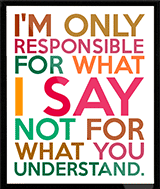
or we could use a shared
Lean Glossary...
Indirect Research
Examples: Industry publications, published studies, market share analysis, industry experts…
Advantages: Fast. Sometimes cheap. Provides perspective from outside your own organizational boundaries.
Disadvantages: Might not answer all of your questions. Might not be segmented in all desired ways.
Tip: It is important to understand the details of the research methods, population profiles, and sample sizes used by the independent researcher.
Direct Research
Examples: Process observation, telephone interviews, face-to-face interviews, focus groups, surveys, questionnaires, e-survey, point of use observation...
Advantages: Very flexible to obtain the exact information desired.
Disadvantages: Slow. Expensive. Requires substantial expertise to properly design the questions, operational definitions, and/or data collection techniques, and to adequately train and supervise the people collecting the data.
Data Collection Tips & Training
for your Voice of the Customer template
Tip: For every type of data collected, be sure to segment your data in all of the ways defined within your Customer Segmentation Worksheet and the segmentation decisions you made using your Tree Diagrams
Voice of the Customer Translation
Why?
Why translate the voice of your customer?
Use your Voice of the Customer Translation template (VOC_Kano.xlsx)
to translate potentially vague customer comments
into measurable functional requirements
that your design and process engineers can understand and quantify.
This exercise is extremely valuable in and of itself, even if you stop there...
or you can optionally transcribe those functional requirements
to a Cause & Effect Matrix or a House of Quality QFD Matrix
for further clarification of that all-important question:

"What do our customers want from us?"
Are we offering what our customers actually want?
How to use your
Voice of the Customer template
Before you begin
Before you begin using your Voice of the Customer Translation template (VOC_Kano.xlsx) you should have already completed several preparatory steps.
You should have already defined your Product and Service Families using your Product Family Matrix template (vsmProductFamily.xlsx)
You should have already segmented your customers into like-minded groups using your Customer Segmentation template (CustSegment.docx)
You should have already collected your Voice of the Customer data (for each customer segment) using your Voice of the Customer Data Collection template (VOC_Data.docx) and your Customer Wants worksheet (VOC_Wants.docx)


Find and open your template
Find and open your Voice of the Customer template
(VOC_Kano.xlsx)
in the same way that you find and open your other 150+ Systems2win templates.

Save your working document
following the usual document storage and naming conventions established by your leaders
If English is not your preferred language
Switch to your language, just like every Systems2win Excel template.
Now your team is ready to start doing
Voice of the Customer Translation
Step 1) Organize your workbooks and worksheets
Create a separate workbook for each Product or Service Family.
Create a separate worksheet for each Customer Segment.
Excel Ribbon bar > Systems2win tab > Open a Blank Sheet

Rename your new sheets
Step 2) Define the Product, Service, or Output being studied
In the 'Product' header field, answer the question: "Requirements for what?"
Step 3) Define the Target Customer Segment being studied
Here's where the work that you did pays off.
Transcribe and paraphrase from your Customer Segmentation worksheet.
Step 4) Summarize Voice of the Customer
Using the Voice of the Customer data that you already collected...
In the 'Voice of the Customer' column, document your customer's feedback for why this type of customer would or would not want to buy your product or service.
Some customer comments will be unique to a single customer segment, while other comments are relevant to multiple customer segments, and therefore should be duplicated on multiple worksheets
Use double quote marks (" ") for exact customer quotes.
Use single quote marks (' ') for reworded paraphrases of typical customer comments.
Tip: Because you use a single quote in Excel to indicate that a cell contains text, you will need to type the single quote twice in order for the second one to appear.
Perhaps use Affinity Grouping or a Tree Diagram to combine similar themes.
Use the first column to differentiate Output requirements from Service requirements.

You'll get a lot more out of this training if you have your template open in front of you
See the pop-up help
and the example on the Sample sheet
Regardless of whether the primary output is a product or a service, your team should always identify a balance of customer requirements for both:
- Output requirements
Features of the final product or service delivered to the customer at the end of the process
- Service requirements:
How do our customers want to be treated?
Step 5) Clarify the Root Concerns for each Customer Comment
"Why say that?"
Most customer comments are somewhat vague, and some are extremely vague.
Try to understand what lies beneath the comment.
Rather than guessing,
it is always better to ask the client to clarify what was meant...
or at least to validate or invalidate your guesses.

Step 6) Translate to observable, measurable functional requirements
Guidelines: A good functional requirements statement:
- Is single-focused.
If a statement addresses separate issues, separate them into separate requirements.
Even if contained within a single cell, as illustrated in the sample data with requirements separated by dashed lines
- Is observable and measurable.
- Clearly defines what is a defect
What is acceptable and not acceptable? (Ask your customer)
- Is directly related to the product or service.
- Clearly describes the need - not how to solve it.
Leaving maximum flexibility for creative solutions.
- Is as concise as possible
but not so concise that it fails to accomplish the above guidelines.
Step 7) Validate
Show this document to representatives of each customer segment, to your sales representatives, field service people, and anyone else that can shed light from different perspectives to answer the question:
"Do these statements accurately describe what our customers in this market segment really want from this product or service?"
Step 8) Perform Kano Analysis
And while validating, it is a good time to also perform a Kano Analysis.
Ask your customers these questions:
"How would you feel if this need WAS addressed?"
"How would you feel if this need WAS NOT addressed?
Tally the responses for each requirement from all of your customers (perhaps divided into customer segments), then use the Kano Analysis grid key to classify the most common response for each requirement as:
1) Delighter
Unexpected, but appreciated
2) Dissatisfier
Customer only notices (and gets upset) if missing
3) Satisfier
The usual 'more is better' criteria that most customers compare when shopping for this product or service

4) Leave the cell blank if:
- Confused response
- Indifferent
- Reverse response that can't be rephrased the opposite way to become a Delighter or Dissatisfier.
Your assumptions were wrong.
For example, you assumed your customer wants fast service, and your customer actually wants to linger.
Kano Analysis |
How would you feel if this need... WAS NOT addressed? | ||||
|---|---|---|---|---|---|
| Like it | Not expected | Don't care | Wouldn't like | ||
| WAS addressed? |
Like it | Confused response | Delighter | Delighter | Satisfier |
| It's expected | Reverse the question | Indifferent | Indifferent | Dissatisfier | |
| Don't care | Reverse the question | Indifferent | Indifferent | Dissatisfier | |
| Wouldn't like | Reverse the question | Reverse the question | Reverse the question | Confused response | |
Kano Analysis
Step 9) Refine or revise

Step 10) Use your Voice of the Customer insights
Distribute this document to everyone that needs to know
performance expectations and measures for this combination of product/service and customer segment.
In addition to your Marketing and Sales people, and your C-Suite (old people in suits), your Voice of the Customer analysis results will also be of great interest to the members of your cross functional teams responsible for product development and those team member will probably want to use your VOC data in some of your other templates for measurement selection, such as...




Voice of the Customer templates
with DMAIC tools and DFSS Design for Six Sigma tools
to empower every team member

Wouldn't it be nice to work in a place that has better tools and systems?
Own Yours Now
If your organization has
not yet provided a license,
own yours now
New User Training
Your Systems2win templates come with free New User Training
to quickly learn features that are common to all 150+ templates
Training and Coaching
Consider Training and Coaching to support your teams to succeed

Training to get you started.
Tools you won't outgrow.
Schedule a Conference
Schedule a conference
to discuss your challenges
with an experienced lean advisor






